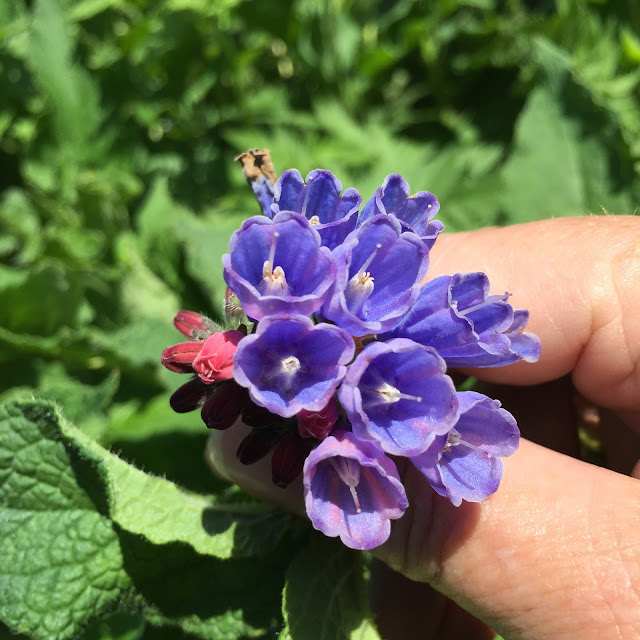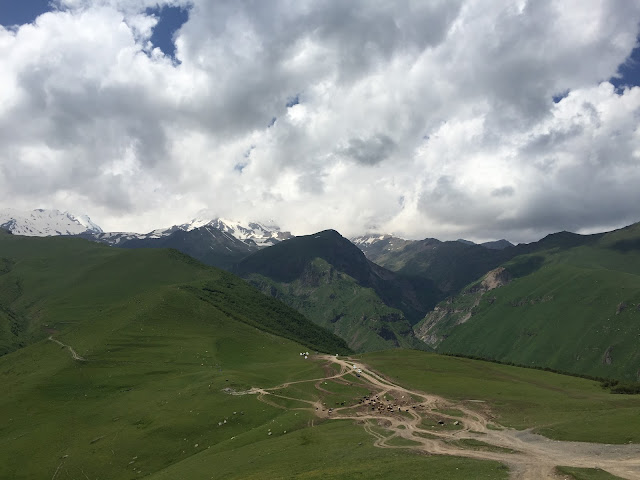 |
| Mtskheta |
Our next destination was the ancient capital and religious centre of Georgia, Mtskheta - one of the oldest cities in Georgia and one of the oldest contunuously-inhabited cities in the world, with its UNESCO World Heritage sites - Jvari Monastery Church of the Holy Cross and Svetitskhoveli Cathredral. The Church of the Holy Cross is built on the site where a cross was planted to mark the christian victory over the pagans around C4. Hundreds of photographs later ,,,,,,,
 |
| Church of the Holy Cross on its high rocky perch |
 |
| This cross is situated above the platform of the original cross |
 |
| Father David with our guide, Nino - they were from the same village |
 |
| Svetitskhoveli Cathredral |
 |
| St Nino Cross was originally made of grapevines lashed together with her hair |
 |
| Magnificent |
The spiritual ambiance of these places had us whispering and wishing we could dwell in the silence for a while longer. But we were swept northward on the famous Georgian Military Highway (more later). It was an incredibly beautiful drive through 'gorgeous' valleys and woodlands to the ski resort of Gudauri. On the way we stopped for a quick look at the medieval Anauri Architectural Complex where an old fortress still sheltering chapels, monuments, monasteries and an old watch tower, as well as a prison.
 |
| Anauri Architectural Complex |
 |
| The Old watchtower |
 |
| So many of the frescos we saw here and elsewhere had been vandalised |
 |
| Lindsay had a marvellous time exploring the fortified walls |
After an overnight stay in Gudauri, we travelled further north on the Georgian Military Road which is 200km long and runs between Tbilisi and Vladikavkaz in North Ossetia across the Great Caucasus Range. The road has existed as a route for traders and invaders since before the 1st century BC (including as part of the Old Silk Road) but was only a crude horse trail until the Russians converted it into a carriage road in the late C18. Today it leads to the only legal border crossing point to Russia.
The drive was stunning, breathtaking, awe inspiring, extraordinary, incredible - merely words which can't possibly describe what we saw as we drove. A place that could almost convinced you to stay and become shepherds.
 |
| Gudauri |
 |
| An oddity along the route. An old Soviet period lookout covered in historic 'grafitti' |
 |
| Cows have right of way ... |
 |
| ... but they would move over for you on very narrow roads |
Towering mountains, steep slopes blanketed in vivid green and glorious wild flowers - yellows, white, purples, blues, pinks. Colours in a myriad of shades, flowers in many shapes from the simple pea flower through bells, daisies to more intricate complexes designed to capture passing insects and the meadow bees who hovered like wooly drones lazily buzzing from one flower to another. Butterflies like handfuls of confetti scattered over paths and banks competed with wandering cows along most roads. I so wish that I could paint!
We were following beside the Tergi river into the Sno valley and then via very narrow roads deeper into the High Caucasus - we were surrounded by the gorgeous mountains. Gia, our marvellous driver, drove us through isolated, rugged terrain. alongside raging streams up blind valleys - we were heading for Juta at the end of Sno Valley where the road, mere wheel ruts much of the way, finally petered out.
We climbed through herbs and flowers as high has an elephants eye (almost!) to visit a family in the village of Juta. There we were fed on mountain honey and fresh-made cheese with bread straight out of the oven. Juta is completely cut off from the world for 6 months of the year by snow. It can be a hard life but the simplicity is enticing. We watched eagles soar over high mountain pastures dotted with sheep and goats watched over by shepherds who camp out with their flocks in the summer months.
 |
| The home where we stopped for honey and cheese |
 |
| A three-horned goat's head hung in the tree to ward off evil so we were safe |
 |
| The attempted confluence of two rivers |
We travelled and stopped by raging ice-cold torrents barreling through valleys and deep mountain crevasses or spurted from beneath sheets of ice. Some rivers were bi-colored because they flowed so fast that the tributary waters couldn't mix - a grey churning flow beside a black roiling torrent, the confluence of mountain rivers reluctant to give up their own identities.





































































